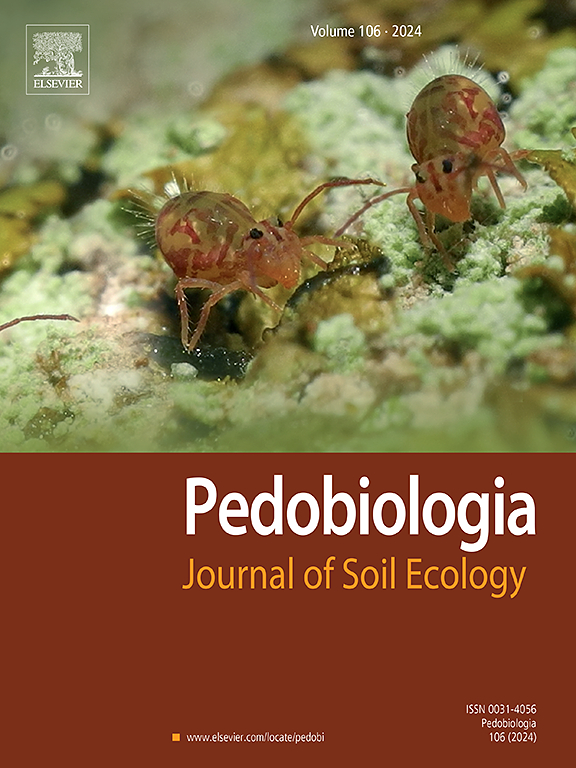Greater influence of eukaryotes on carbon degradation potentials than prokaryotes along an elevation gradient
IF 2.2
3区 农林科学
Q3 ECOLOGY
引用次数: 0
Abstract
Prokaryotic and eukaryotic microbial diversities are regulated by soil properties (e.g., soil organic matter, SOM), but their interactions and capacity to degrade carbon compounds remain unclear due to vegetation succession along elevation and climatic gradients. Fresh soils from different elevations and climates were collected from five sites covering different vegetation distributed vertically in the typical subtropical zone of Wuyishan. The community composition of microorganisms, carbon-degrading potentials and soil properties were analysed. The results showed that SOM, i.e., organic carbon, humus and fulvic acid, increased significantly along the vegetation types that existed along the elevation gradients. Prokaryotic and eukaryotic communities were distinguished by elevation and vegetation type, respectively. The pivotal role of prokaryotes in co-occurrence network was stronger than that of eukaryotes. The available potassium, organic carbon, humus, fulvic acids and humin carbons significantly affected the composition of prokaryotes and eukaryotes. In contrast, ammonium and available phosphorus alone affected the prokaryotic community composition, while pH and nitrate only affected the eukaryotic community composition. Correlations between carbon utilization potential and dominant eukaryotic taxa were more intense than those with prokaryotic taxa. Compared with prokaryotes, the carbon utilization potentials of eukaryotic taxa were more limited by changes in climate driven by increasing elevation. Our study illuminated that the differences in elevation gradient and vegetation type jointly drove the distinct diversity of the microbial communities and further affected their carbon-degrading potential. It would give insight into predict the effects of microorganisms on the carbon content transformation of different vegetation types under climate change.
沿着海拔梯度,真核生物对碳降解潜力的影响比原核生物更大
原核和真核微生物多样性受土壤性质(如土壤有机质)的调节,但由于植被沿海拔和气候梯度的演替,它们的相互作用和降解碳化合物的能力尚不清楚。在武夷山典型亚热带不同植被垂直分布的5个站点采集不同海拔和气候的新鲜土壤。分析了土壤微生物群落组成、碳降解潜力和土壤性质。结果表明:土壤有机质(有机碳、腐殖质和黄腐酸)沿高程梯度分布的植被类型显著增加;原核生物群落和真核生物群落分别以海拔高度和植被类型区分。原核生物在共现网络中的关键作用强于真核生物。速效钾、有机碳、腐殖质、黄腐酸和人类碳对原核生物和真核生物的组成有显著影响。铵态氮和有效磷单独影响原核生物群落组成,而pH和硝酸盐只影响真核生物群落组成。碳利用潜力与优势真核类群的相关性比与优势原核类群的相关性更强。与原核生物相比,真核生物类群的碳利用潜力更受海拔升高引起的气候变化的限制。研究表明,海拔梯度和植被类型的差异共同驱动了微生物群落的明显多样性,并进一步影响了它们的碳降解潜力。这将有助于预测气候变化下微生物对不同植被类型碳含量转化的影响。
本文章由计算机程序翻译,如有差异,请以英文原文为准。
求助全文
约1分钟内获得全文
求助全文
来源期刊

Pedobiologia
环境科学-生态学
CiteScore
4.20
自引率
8.70%
发文量
38
审稿时长
64 days
期刊介绍:
Pedobiologia publishes peer reviewed articles describing original work in the field of soil ecology, which includes the study of soil organisms and their interactions with factors in their biotic and abiotic environments.
Analysis of biological structures, interactions, functions, and processes in soil is fundamental for understanding the dynamical nature of terrestrial ecosystems, a prerequisite for appropriate soil management. The scope of this journal consists of fundamental and applied aspects of soil ecology; key focal points include interactions among organisms in soil, organismal controls on soil processes, causes and consequences of soil biodiversity, and aboveground-belowground interactions.
We publish:
original research that tests clearly defined hypotheses addressing topics of current interest in soil ecology (including studies demonstrating nonsignificant effects);
descriptions of novel methodological approaches, or evaluations of current approaches, that address a clear need in soil ecology research;
innovative syntheses of the soil ecology literature, including metaanalyses, topical in depth reviews and short opinion/perspective pieces, and descriptions of original conceptual frameworks; and
short notes reporting novel observations of ecological significance.
 求助内容:
求助内容: 应助结果提醒方式:
应助结果提醒方式:


